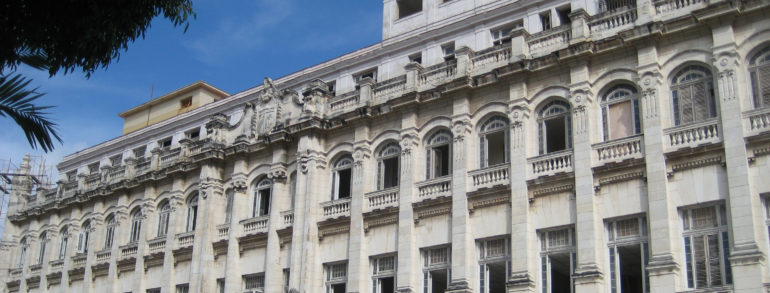The Museum tour: 1-day passes for $9 USD; you can purchase a 1-day ticket at the Museo de la Ciudad allowing you entrance to this museum and its Casa de la Plata and the following:
- Casa de los Arabes (with restaurant, Al Medina) opposite, on Oficios between Obispo and Obrapía. A lovely building with vines trained over the courtyard for shade (open daily 9:30 am - 6:30 pm, $1 USD).
- Casa de Africa, on Obrapìa 157 between San Ignacio and Mercaderes (Mon-Sat 10:30 am - 5:30 pm, Sun 9:30 am - 12:30 pm, $2 USD), a small gallery of carved wooden artifacts and handmade costumes.
- Vintage Car Museum, Oficios y Jústiz (just off Plaza de Armas, open daily 9:00 am - 7:00 pm, $1 USD), there are a great many museum pieces, pre-revolutionary U.S. models, still on the road especially outside Havana, in among the Ladas, VWs and Nissans.
- Casa de Guayasimìn, Obrapìa entre Mercaderes y Oficios, exhibition of works donated to Cuba by Ecuadorean artist Oswaldo Guayasimìn (paintings, sculpture and silkscreens) and occasionally other exhibitions, the upstairs part is being converted into studios so he can work here, Guayasimìn painted a famous portrait of Fidel Castro for his 70th birthday with his hands raised.
- Casa de México, opposite the above, also called La Casa de Benito Juárez, Obrapía entre Mercaderes y Oficios, a museum of Mexico in a pink building marked with the Mexican flag (open Tues-Sat 10:30 am - 5:30 pm, Sun 9:30 am - 12:30 pm, $1 USD).
- Casa de Simón Bolívar, Mercaderes entre Obrapía y Lamparilla, contains exhibits about the life of the South American liberator (open Tues-Sat 10:30 am - 5:30 pm, Sun 9:30 am - 12:30 pm, $1 USD).
- Casa de Asia, Mercaderes entre Obrapía y Obispo, converted from a solar, multi-family dwelling with a central courtyard, into an exhibition space of art, furniture and other artifacts donated from the Asian subcontinent, bonsai plants are being cultivated in the central courtyard, for sale in a shop next door, the funds will be used to set up the museum display.
Finca La Vigía
Ten miles east of Havana is Hemingway's Cuba house - Finca Vigía, meaning "lookout house".
Finca Vigía is located in the small, working-class town of San Francisco de Paula. The Cuban people have always respected famous writer's choice to live in a modest town, amongst the people he fished with.
Built in 1886 by a Spanish Architect Miguel Pascual y Baguer, Finca Vigía was purchased by Hemingway in 1940 for a cost of $12,500.
There, Hemingway wrote two of his most celebrated novels: For Whom the Bell Tolls and The Old Man and the Sea. A Movable Feast was written there as well.
After Hemingway's death in 1961, the Cuban government took ownership of the property - either with or without the approval of Mary Hemingway.
After years of neglect, restoration and preservation work has begun.
Finca Vigía has made both the World Monuments Fund list of 100 Most Endangered sites, and The National Trust for Historic Preservation’s 11 Most Endangered Places.
Finca Vigía and the Hemingway Museum are located in the town of San Francisco de Paula.
The Hemingway Museum at Finca Vigía is currently scheduled to be open 10am to 4pm, Monday thru Saturday; 9am to 1pm, Sunday. The entrance fee is 5CUC.
Expect occasional closures - usually attributed to renovations.
Museum of Decorative Arts
Installed in the sumptuous former mansion of the Countess of Revilia de Camargo, this museum exhibits a grand collection of valuable pieces and works of art.
The most varied samples of the applied arts are shown in the permanent and temporary exhibits: the fine cabinet work and joinery of French and English furniture in the styles prevalent in the 18th century; original collections of Meissen, Sevres, Wedgewood and Faillance china; collections of Oriental porcelains; and Bacarat, Venetian and Catalonian crystal.
A rug woven by hand in 1772, by Franchis Carolus Romanus, is one of the museum's most treasured pieces. There is also and important collection of Chinese screens, including an outstanding 17th century Coromandel. The luxuriously and majestically decorated "halls" comprise the Main Hall, done in rococo with gilt and goldleaf wall decorations and the Neoclassical Haii (the Countess' bedroom) with a secretaire that once belonged to Queen Marie Antoinette.
Collections: China and Porcelains; Furniture; Paintings and Sculptures; Applied Arts.
Address: Calle 17 No.502 e/ D y E, Vedado
Open: Tuesday to Saturday: 11:00 am to 6:30 pm, Sundays: 9:00 am to 1:00 pm, Closed Mondays

